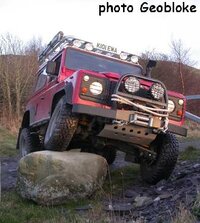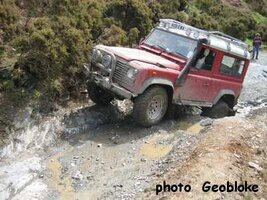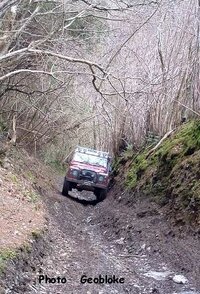This article will deal with some of the more rugged terrain you may encounter whilst off-road.
Driving on rough tracks

You can of course drive rough tracks in 2 wheel drive…however if the surface is at all loose, or there is a possibility of excessive suspension travel, you should engage 4WD (or use the difflock, where appropriate) as a matter of course. The possibility of too much axle articulation can lead to loss of traction in 2WD if one wheel should lift off the ground. Low range should be engaged if you need to travel slowly enough to warrant it…this will make it easier to manoeuvre, and will mean that you wont have to be constantly using the brake or clutch.
Braking
Ideally, you should keep the use of the brake to a minimum. Using the brake on a wet, slippery or loose surface could result in one (or more) wheels locking, and the loss of control over the vehicle could be disastrous and dangerous.
Engine Braking
‘Engine braking’ is the method employed to slow a vehicle down without using the brake. This method is ideal for descending steep slopes.

Engage first gear, in the low box, again with the difflock engaged where appropriate, before attempting the descent. (the idea being that even if one wheel on an axle slips or loses grip, then the rest will still operate under engine braking) Then proceed forwards down the slope…the engine will provide sufficient slowing of the vehicle to control the rate of the descent. REMEMBER the brakes should not be applied as this may result in one or more wheels locking up, which will result in loss of control of the Landy. Neither should you depress the clutch whilst employing engine braking...you most certainly do not want to freewheel downhill!
Steep slopes

It is very important to remember that you should follow the ‘slope’ of the hill you are climbing or descending… IE, ideally, you should not drive across a slope at an angle, as doing so can result in the vehicle sliding broadside down the slope, or you could even possibly end up rolling the Landy over!
So, when approaching a steep upward slope, and especially if the surface is loose or slippery you should aim to go straight up, using as high a gear as is possible as a higher gear and the resultant momentum can aid you in the ascent.
That being said, too much speed on a surface which is uneven or bumpy can result in a wheel lifting, loss of traction and then stopping. You may find that the grip can be improved by easing off the throttle pedal slightly before you lose forward movement. Again, this is one of those situations where driver experience comes into play…knowing what gear and speed to use.
If you should fail to ascend the climb, but you managed to stop without stalling you should proceed as follows.
1. Hold the vehicle still on the hill with the footbrake. You should only need to use the handbrake/transmission brake if the footbrake fails to hold because of wet shoes or discs/pads.
2. Engage reverse gear, low range.
3. Release the brake and clutch at the same time.
4. Allow the Landy to reverse down the slope using the engine braking effect described above.
5. DO NOT apply the brakes as you descend…even just touching the pedal can result in the front wheels locking, and you will lose control of the steering.
If you stalled whilst ascending, then the following procedure should be used.
A. Hold the vehicle on the footbrake or handbrake/transmission brake.
B. Engage reverse gear in the low box and remove your feet from the brake and clutch pedals.
C. Start the engine in gear, and allow the Landy to reverse down the hill using engine braking as before. A loaded vehicle will start without using the starter as soon as the brakes are released if the slope is steep enough, and if there is enough grip.
D. If you have an automatic gearbox, you MUST apply the brakes and restart the engine before attempting to reverse down the hill, as without the engine running there will be no braking effort from the gearbox.
Once back on the level ground, or where you can regain traction, a faster approach may be used, and the resulting extra forward speed may well aid you in finally completing the climb.
Crossing a ridge
Aim to approach a ridge at right angles. This should ensure that both front wheels and then both rear wheels cross the ridge together. If you approach at an angle there is every chance that diagonally opposite wheels may lose contact with the ground, resulting in a loss of traction. Be aware of the length of your vehicle...you do not want to find yourself sat with the centre of the landy suspended on the ridge!
Driving in a ‘V’ shaped Gully

Ideally you should approach a V shaped gully with caution. Try to keep the Landy on an even keel, trying to follow the contours, and avoid steering up one or other sides of the gully, as you may end up with the Landy being stuck with it’s side trapped on the gully wall.
Traversing, or crossing a slope
Having touched on this briefly already, here’s a bit more information.
If you have to do this, walk the route you intend to take first. Check that the ground is firm, and not slippery. Check to see that the wheels on the downhill side of the vehicle are not likely to drop into any holes or depressions in the ground, as this will result in an increased angle of lean on the vehicle. For the very same reason, check that the uphill side wheels are not going to hit rocks or other obstacles which will result in the same effect.
Loads in the rear of the vehicle should be as low as possible, and any passengers in the rear tub should sit on the uphill side if possible, and stay put! You don’t want them suddenly moving to the lower side, and maybe causing you to lose control!
Do not steer uphill as you traverse downhill…again, you could roll the vehicle. Aim to steer downhill wherever possible, and follow gravity (as it will win every time!)
Finally
Drive safe, and be aware of your surroundings. Have fun!
Click for part 1 | Click for part 2
Driving on rough tracks

You can of course drive rough tracks in 2 wheel drive…however if the surface is at all loose, or there is a possibility of excessive suspension travel, you should engage 4WD (or use the difflock, where appropriate) as a matter of course. The possibility of too much axle articulation can lead to loss of traction in 2WD if one wheel should lift off the ground. Low range should be engaged if you need to travel slowly enough to warrant it…this will make it easier to manoeuvre, and will mean that you wont have to be constantly using the brake or clutch.
Braking
Ideally, you should keep the use of the brake to a minimum. Using the brake on a wet, slippery or loose surface could result in one (or more) wheels locking, and the loss of control over the vehicle could be disastrous and dangerous.
Engine Braking
‘Engine braking’ is the method employed to slow a vehicle down without using the brake. This method is ideal for descending steep slopes.

Engage first gear, in the low box, again with the difflock engaged where appropriate, before attempting the descent. (the idea being that even if one wheel on an axle slips or loses grip, then the rest will still operate under engine braking) Then proceed forwards down the slope…the engine will provide sufficient slowing of the vehicle to control the rate of the descent. REMEMBER the brakes should not be applied as this may result in one or more wheels locking up, which will result in loss of control of the Landy. Neither should you depress the clutch whilst employing engine braking...you most certainly do not want to freewheel downhill!
Steep slopes

It is very important to remember that you should follow the ‘slope’ of the hill you are climbing or descending… IE, ideally, you should not drive across a slope at an angle, as doing so can result in the vehicle sliding broadside down the slope, or you could even possibly end up rolling the Landy over!
So, when approaching a steep upward slope, and especially if the surface is loose or slippery you should aim to go straight up, using as high a gear as is possible as a higher gear and the resultant momentum can aid you in the ascent.
That being said, too much speed on a surface which is uneven or bumpy can result in a wheel lifting, loss of traction and then stopping. You may find that the grip can be improved by easing off the throttle pedal slightly before you lose forward movement. Again, this is one of those situations where driver experience comes into play…knowing what gear and speed to use.
If you should fail to ascend the climb, but you managed to stop without stalling you should proceed as follows.
1. Hold the vehicle still on the hill with the footbrake. You should only need to use the handbrake/transmission brake if the footbrake fails to hold because of wet shoes or discs/pads.
2. Engage reverse gear, low range.
3. Release the brake and clutch at the same time.
4. Allow the Landy to reverse down the slope using the engine braking effect described above.
5. DO NOT apply the brakes as you descend…even just touching the pedal can result in the front wheels locking, and you will lose control of the steering.
If you stalled whilst ascending, then the following procedure should be used.
A. Hold the vehicle on the footbrake or handbrake/transmission brake.
B. Engage reverse gear in the low box and remove your feet from the brake and clutch pedals.
C. Start the engine in gear, and allow the Landy to reverse down the hill using engine braking as before. A loaded vehicle will start without using the starter as soon as the brakes are released if the slope is steep enough, and if there is enough grip.
D. If you have an automatic gearbox, you MUST apply the brakes and restart the engine before attempting to reverse down the hill, as without the engine running there will be no braking effort from the gearbox.
Once back on the level ground, or where you can regain traction, a faster approach may be used, and the resulting extra forward speed may well aid you in finally completing the climb.
Crossing a ridge
Aim to approach a ridge at right angles. This should ensure that both front wheels and then both rear wheels cross the ridge together. If you approach at an angle there is every chance that diagonally opposite wheels may lose contact with the ground, resulting in a loss of traction. Be aware of the length of your vehicle...you do not want to find yourself sat with the centre of the landy suspended on the ridge!
Driving in a ‘V’ shaped Gully

Ideally you should approach a V shaped gully with caution. Try to keep the Landy on an even keel, trying to follow the contours, and avoid steering up one or other sides of the gully, as you may end up with the Landy being stuck with it’s side trapped on the gully wall.
Traversing, or crossing a slope
Having touched on this briefly already, here’s a bit more information.
If you have to do this, walk the route you intend to take first. Check that the ground is firm, and not slippery. Check to see that the wheels on the downhill side of the vehicle are not likely to drop into any holes or depressions in the ground, as this will result in an increased angle of lean on the vehicle. For the very same reason, check that the uphill side wheels are not going to hit rocks or other obstacles which will result in the same effect.
Loads in the rear of the vehicle should be as low as possible, and any passengers in the rear tub should sit on the uphill side if possible, and stay put! You don’t want them suddenly moving to the lower side, and maybe causing you to lose control!
Do not steer uphill as you traverse downhill…again, you could roll the vehicle. Aim to steer downhill wherever possible, and follow gravity (as it will win every time!)
Finally
Drive safe, and be aware of your surroundings. Have fun!
Click for part 1 | Click for part 2
